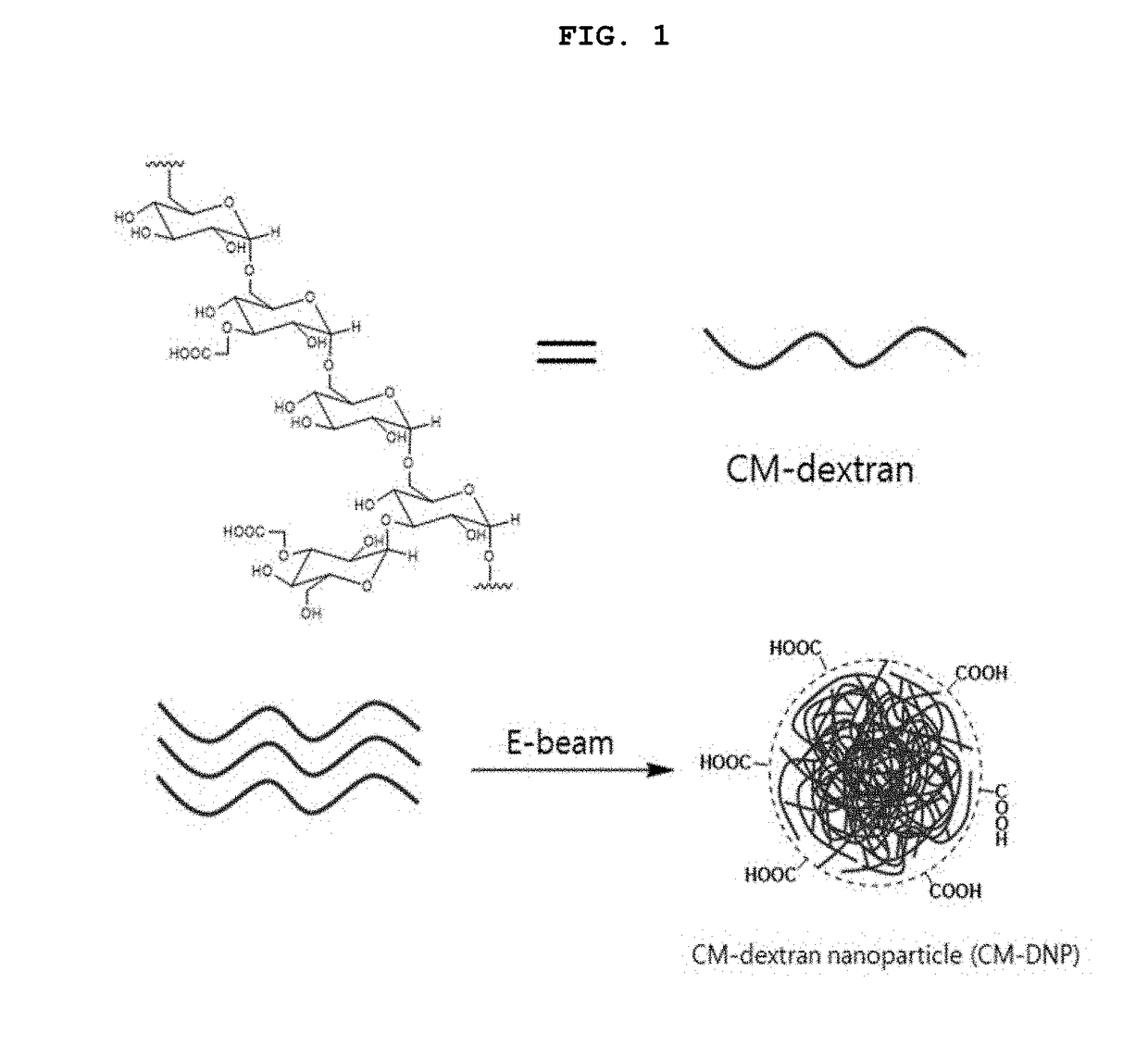Biocompatible nanoparticle and use thereof
a biocompatible and nanoparticle technology, applied in the direction of aerosol delivery, immunological disorders, metabolism disorders, etc., can solve the problems of harmful effects when used in the biological body, hydrogels are not suitable for medical and pharmaceutical use, and cost increases due to
- Summary
- Abstract
- Description
- Claims
- Application Information
AI Technical Summary
Benefits of technology
Problems solved by technology
Method used
Image
Examples
example 1
Conditions for Electron Beam Irradiation Using Electron Beam Accelerator and Preparation Therefor
[0139]Experiments were conducted by applying an electron beam with various dose conditions to a solution to be irradiated. In the experiments, a linear electron beam accelerator was used, and an electron beam with doses of 5 kGy, 10 kGy, 50 kGy, 100 kGy, and 200 kGy was applied to a sample on a conveyor moving at a predetermined rate in a manner of adjusting the electron beam and the irradiation time. The irradiation time of the electron beam and the irradiation dose thereof can be properly adjusted and selected by a person skilled in the art according to the size of nanoparticles to be produced, in consideration of the temperature condition at the time of electron beam irradiation, the sample concentration, the energy intensity of an electron beam to be irradiated, and the like.
example 2
Preparation of Nanoparticles by Electron Beam Irradiation
[0140]2-1. Carboxymethyl-Dextran Solution and Electron Beam Irradiation Conditions
[0141]Nanoparticle synthesis experiments were conducted using carboxymethyl-dextran. Electron beams were applied to samples to be irradiated by using a linear electron beam accelerator while the electron beam irradiation conditions were varied in a manner of adjusting the beam current and irradiation time.
[0142]More specifically, carboxymethyl-dextran (molecular weight: 10 kDa) was dissolved in water to prepare solutions with concentrations of 0.1%, 0.5%, 1%, 5%, 10%, and 20% (w / v), and the experiments were conducted while the electron beam irradiation energy dose with respect to the carboxymethyl-dextran solutions was varied to 5 kGy, 10 kGy, 50 kGy, 100 kGy, and 200 kGy. Any additive, such as an organic solvent, a crosslinking agent, or an inorganic material, was not added to the prepared carboxymethyl-dextran solutions.
[0143]2-2. Preparation o...
example 3
Evaluation of Physical Properties of Carboxymethyl-Dextran Nanoparticles (CM-DNP)—Characteristics of Gel
[0173]The samples irradiated with the electron beam were dialyzed using a dialysis membrane tube with a size of 3.5-6 kDa while water containing NaCl was exchanged two times a day for 5 days. It was investigated through DLS whether the particle size was changed, but it could be confirmed that the particle size did not change during the dialysis procedure. Thereafter, the samples were freeze-dried to calculate the yield of nanoparticles formed through crosslinking by the irradiated electron beam. A yield of about 43% was obtained and a total of 8.2 g of nanoparticles were obtained.
[0174]Experiments were conducted, by using nanoparticles manufactured according to the examples above, to investigate whether these nanoparticles show gel characteristics. After 0 mg, 100 mg, 200 mg, and 300 mg of CM-DNP were dissolved in 400 uL of water, centrifugation using a centrifugal filter (YM-3) w...
PUM
| Property | Measurement | Unit |
|---|---|---|
| Irradiation dose | aaaaa | aaaaa |
| Composition | aaaaa | aaaaa |
| Biocompatibility | aaaaa | aaaaa |
Abstract
Description
Claims
Application Information
 Login to View More
Login to View More - R&D
- Intellectual Property
- Life Sciences
- Materials
- Tech Scout
- Unparalleled Data Quality
- Higher Quality Content
- 60% Fewer Hallucinations
Browse by: Latest US Patents, China's latest patents, Technical Efficacy Thesaurus, Application Domain, Technology Topic, Popular Technical Reports.
© 2025 PatSnap. All rights reserved.Legal|Privacy policy|Modern Slavery Act Transparency Statement|Sitemap|About US| Contact US: help@patsnap.com



